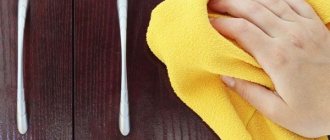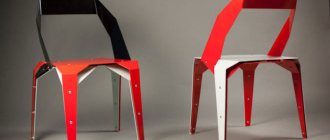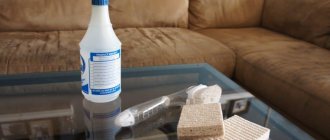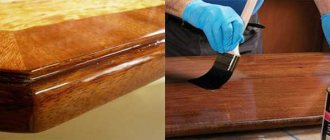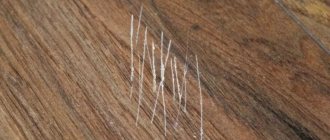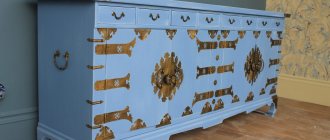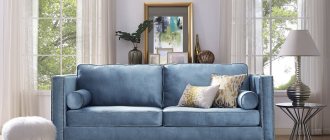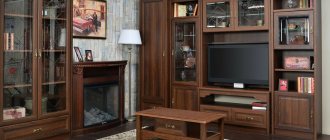Purpose
The main task of the described supports is to provide stability and change the height of furniture modules. Traditionally, such fittings were rigidly attached to the body of the product and formed a single structural element with it. Today these are separate parts that have an expanded range of capabilities and can be used in conjunction with different objects. Identical products can be quite successfully installed on upholstered or cabinet furniture. This versatility allows the supports to be produced separately from other parts along with various types of fittings.
In addition to the main function, supports are capable of solving related problems:
- compensate for uneven floors and level the position of furniture;
- change the height of objects within a few centimeters;
- limit the opening of doors (special limiters are used for this - furniture stoppers);
- create a decorative effect.
What is a thrust bearing and why is it needed?
Thrust bearings are a furniture element that is installed on the legs to prevent damage to the floor when rearranging cabinets, tables, chairs and other things. It is also used to hide defects on the lower ends of the sides of chests of drawers. Furniture bearings have a wide range of functional purposes.
- Protection of floors made of different materials from scratches and other defects;
- Simplifying the process of moving furniture;
- Protecting the bottom of the cabinets from moisture, thereby increasing the service life of the chests of drawers;
- Ability to adjust the slope of the furniture during installation.
The design of the thrust bearing usually consists of durable plastic. The material can withstand significant loads. The shape of the products is round, square and triangular. Self-adhesive support is made of felt. The range of accessories is quite diverse. You can choose the best option for any furniture.
What is it and how does it work?
Thrust bearings are fittings that are used to protect the floor or floor covering from damage if it is necessary to move heavy furniture without leaving marks on it. They are attached to the lower ends of the sides of cabinets and chests of drawers. It can also be used to “mask” defects on furniture elements. The main functions of thrust bearings are:
- prevention of scratches and other damage to floor coverings made of various materials, including linoleum;
- facilitating the movement and transportation of furniture on any surface;
- maintaining the durability of products and preventing moisture from entering the lower ends of the furniture walls;
- adjusting the slope of products during their assembly and installation.
Thrust bearings are fittings that are used to protect the floor or floor covering from damage.
Adjusting the slope of products during their assembly and installation.
Plastic bearings can withstand the greatest loads.
They are attached to the lower ends of the sides of cabinets and chests of drawers.
It can also be used to “mask” defects on furniture elements.
Prevention of scratches and other damage to floor coverings made of various materials, including linoleum.
They are attached to the lower ends of the sides of cabinets and chests of drawers.
It seems that, like any product, thrust bearings should have advantages and disadvantages.
Depending on the use, thrust bearings differ in size, shape and material from which they are made.
Preserving the durability of products and preventing moisture from entering the lower ends of the furniture walls.
Adjusting the slope of products during their assembly and installation.
Plastic bearings can withstand the greatest loads.
How to install thrust bearings on furniture?
The soul of furniture is hidden in the details.
Furniture thrust pad - felt, plastic
Special support - furniture thrust bearing
(furniture makers classify it as fittings for furniture assembly) - a product that allows you to assemble and install any element of the set, from the slide section to the transforming sofa, absolutely perfectly evenly.
In other words, the furniture thrust bearing
necessary when it comes to creating an interior without errors, be it a respectable meeting apartment, a luxurious living room in the Empire style or a cozy Provence bedroom, where each item is assigned the role of a colorful accent.
Furniture bearings produced by our company are highly valued by furniture makers in all regions of Russia, where our products are presented to wholesalers.
Each furniture support produced at our production sites is a consistently high-quality product that does not raise any complaints from professionals who create luxury furniture.
We offer to buy furniture bearings with delivery, at a cost designed to attract furniture makers for a permanent long-term partnership.
- plastic footrest for furniture;
- felt pad (self-adhesive);
- felt bearing (self-adhesive).
Furniture felt pads
Felt furniture rests are, in other words, felt pads on furniture legs, which allow you to bring the level of furniture to filigree precision during installation and assembly.
Furniture leg pads are designed for fixation on the lower ends:
- large-sized side walls of cabinets, chests of drawers, cabinets, secretaries, cabinets, display cases;
- mobile stools, chairs, ottomans, banquettes, and light armchairs subject to intense load.
Adjustable furniture rests help protect expensive flooring from being crushed and make it easier to move, for example, when preparing the living room for a party.
Soft felt and felt pads for feet
furniture will help protect linoleum and laminate.
At the same time, footrests for furniture
perform a protective function, preventing moisture from penetrating into wood elements during cleaning.
False plank
Thanks to such a simple invention as a false plank, furniture makers can cope with uneven residential surfaces in certain situations. This saving element is installed when the wall is vertical or inclined within 1-10 mm, as well as in the presence of a small wave. The gap between the wall and the cabinet is reduced by pressing the false plank against the wall, or by fixing it vertically through spacers. In this case, the resulting gap often has to be sealed independently with putty, putty or silicone. As an option, it is covered with a plastic decorative corner, which has a cheap price, but helps to hide minor imperfections in furniture problems. Planks are the most aesthetic option, easy to manufacture and install.
Of course, they cannot level the walls, but they are quite capable of hiding minor unevenness. They were also used in closets because a duster brush glued to a sliding door leaves a dirty mark on the wall or wallpaper over the years. And the use of the plank protects the wall from contamination.
Restrictions on the use of planks differ for wardrobes and swing doors. For example, the sliding door can be tilted up to 20-25 mm using the adjusting screws. Let's say that if the wall is tilted by 20-25 mm, theoretically this step will become a solution. But again, there is a possibility of the door jamming when moving towards the opposite wall. And if we add an uneven floor here, then a very ugly gap will form below between the horizontal strip of the sliding door and the floor. Since one corner of the door is strongly raised, all the beauty of the facade will come to naught, so it is advisable to use the plank only when the slope of the wall does not exceed 10 mm, at least definitely not more than 15 mm. When it comes to swing doors, the restrictions on the slope of the walls are more stringent - no more than 1 mm. So if the slopes of the walls absolutely do not fit into the manufacturer’s standards, and everyone has their own today, then a box is considered a more acceptable element for dealing with uneven surfaces.
Where to install the thrust bearing
Hello. This is my first time assembling furniture (kitchen); Among the fittings there is a nail support. Where is it installed - at the very edge of the side walls or indented closer to the drawer? And further. Section for washing. The supply of communications calls into question the installation of the rear wall. Are two gussets at the bottom enough? Thank you.
Mebius wrote: indent closer to the drawer
..Do your sides reach the floor?
Mebius wrote: The communications supply calls into question the installation of the rear wall.
cut out in the back wall with a reserve for communications. You can have scarves, or you can without them!
Not a very correct, but very normal option - screw the section under the sink to the adjacent section (sections, if they are on 2 sides). Needless to say, do you need to screw after the final leveling?
For kitchen furniture, special (CHEAP) adjustable legs are used” >
Who can tell me at what distance from the edges the leg is attached?
1cvirus wrote: at what distance from the edges is the leg attached?
100 mm in the center of the leg for the PM, if there is no PM then it can be closer. From left to right, the best option is in the center of the two sections.
Other options for furniture ties: a brief overview
As we have already found out from the above, the eccentric coupler is one of the most durable fasteners. But it is not always advisable to use this type of connection. Let's look at what other fastenings are used by cabinet furniture manufacturers.
Confirmat
Confirmat is one of the most popular and easy-to-install connection options. Fastening the body parts using confirmations is not difficult or difficult. This type of fastening can only connect elements at right angles.
Confirmat - another detail of furniture fasteners
To install furniture parts using a confirmat, you will need to drill a groove along the diameter of the fastener head in one of the workpieces, the second hole must be made in the end part of the other workpiece, but the diameter will be smaller - usually two drills of 5 and 6 mm are used. Although, you can also use a combination type drill - this is convenient, since you will work with only one tool, and there will be no need for constant replacement.
For greater reliability, confirmations are recommended to be used together with a small wooden rod - a dowel. Such a rod will prevent the workpieces from moving when secured with a confirmat.
This type of coupling, unlike the eccentric one, does not allow parts of the product to be fastened several times
But when using this type of hitch, you should know that chipboard products should be fastened once. Due to the high hollowness of chipboard, re-joining with confirmat does not guarantee a strong screed.
Confirmat is a connection that, unlike an eccentric coupler, is visible on the surface of the product. Therefore, to hide it, you can use decorative stickers or plugs that match the color of the body surface.
Intersectional screed
This fastening method is used when it is necessary to connect modules to each other, for example, cabinets or mezzanines. The coupler consists of two parts - a nut (bushing) and a screw. Since the chipboard used to make the cabinets has different thicknesses, the intersection screed can also be of different sizes.
Intersectional screed
To fasten two modules with this type of connection, it is necessary to align the elements being fastened and drill matching through holes in the two walls of the housing. Insert a bushing on one side, a screw on the other side and tighten with a screwdriver. Sections are fastened.
Furniture corners
This type of fastening has long been known to everyone. They are made of metal and plastic, and are mounted using self-tapping screws. It is not recommended to use corners in those parts of the furniture that are expected to be loaded.
Furniture corners
Table top screed
This type of hitch is used in the production of kitchen sets. It consists of a screw and a pair of stops. Holes for such a screed are made using a Forstner cutter of the required diameter, and a channel for the screw is cut out with a jigsaw.
Holes for such fastening are also made using a Forstner cutter
Why is this necessary?
You already roughly understand what it is. Therefore, you can easily figure out why you need it and why you use it at all for a car mat.
This is most relevant from the driver's seat. The accessory is installed in the area of the pedal assembly, precisely at the point where the heel comes into contact with the surface of the mat.
It is in this area that the mat begins to actively wear out. Bald spots and holes form. This can become an identifier when choosing a used car, by the way.
That is, the appearance of the floor covering noticeably deteriorates. Yes, some people don’t care at all, and they don’t care what happens to the rug. For others, it is very important to restore the coating and at least extend its service life.
There are several reasons to buy such a product:
- this is a way to replace an existing thrust bearing;
- option to enhance wear protection for a new mat;
- addition of coverage where there is no standard thrust bearing;
- increases the service life of mats;
- gives a sophisticated appearance;
- prevents shoes from slipping when driving.
How powerful these arguments are for each specific case must be decided directly by the motorist himself.
Features of eccentrics
Eccentric for a mixer
The design of an eccentric for a mixer is a tube with threads at both ends and with a shifted middle part. Adjustment of dimensions between joints is carried out thanks to this kind of transition. The name “eccentric” consists of two words: “ex” (outside) and “center”, which stands for “outside the center”. The part has two different thread diameters at the edges: wide and narrow. Their sizes are 15mm and 20mm. The standard distance between the axes of the inlets of water pipes is 150 mm.
There are several types of adapters: short, extended and long:
- Adapters with a small shoulder are standard designs of 3-4 cm, usually included with the mixer. In addition to the eccentrics, reflectors are provided - decorative overlays that hide the connections of plumbing fittings. With the help of such adapters, you can adjust the distance up to 8 cm.
- Products with an increased shoulder - are installed when pipes or other obstacles interfere with the installation of the mixer, and allow you to move the faucet from the wall to the required distance.
- Designs with a large shoulder distance - used when there is a significant difference between the outlet distances of water pipes and the mixer pipes.
The length of the eccentric arm is an important characteristic. It indicates the possibility of increasing the distance between the installation points of connection nodes
Products are available in sizes 40 mm, 60 mm and 80 mm. There are corresponding markings: M8, M10 and M12.
The most commonly used products are brass, bronze and stainless steel. According to consumer reviews, budget metal or brass options with a chrome finish are in great demand. Adapters made of brass are preferable, because No rust forms on threaded connections.
The disadvantage of inexpensive products is their fragility when unscrewed from water pipes.
Extensions made of powdered pressed brass, even with slight tightening, often burst and have the only positive quality - low price. Good brass adapters should be solid.
The high quality of eccentrics is guaranteed by well-known companies:
- Remer - extension cords produced by an Italian company. They are of excellent quality, but have a high cost: from 400 to 600 rubles, depending on the shoulder distance.
- Timo - adapters come complete with decorative overlays. Price from 600 rubles.
- Grohe - products made in Germany, made of brass, chrome plated. High quality adapter, price 2500 rubles.
The installation adapters supplied with mixers are generally not suitable in size or quality. Therefore, the purchase of a mixer also implies the additional purchase of eccentrics.
How to use an eccentric coupler?
An eccentric coupler is used to connect various parts. An eccentric tie is used to fasten the tops of various tables, chests of drawers, cabinets, etc.
To use this type of tie, you need to drill two holes in the top of the furniture leg. This action is performed in order to install the clamps.
Similar holes must also be drilled on the end of the furniture. Thanks to this action, you can get an end-to-end channel.
Similar holes must be drilled in the tabletop, into which a rod with a T-shaped head is screwed. The furniture leg must be attached to the tabletop so that their holes coincide.
Next, you need to push the rod through this channel. The final step is to rotate the eccentric. This is done clockwise. An eccentric tie is a fairly high-quality fastener that is widely used for furniture.
Why do you need a floor screed? – see the answer to the question here
When performing this type of screed, it is necessary to position the holes in the parts as accurately as possible. Thanks to this, the tie rod and eccentric are positioned as correctly as possible. Otherwise, you can damage both the door lock and the product itself.
And also watch useful video material about the eccentric coupler:
As mentioned above, to install an eccentric coupler, three holes of different diameters must be made in the parts to be connected.
Materials and features
The following materials are used to make pads for the legs of chairs and other furniture.
- Felt. An almost traditional and universal material, suitable for wood and carpeting. Of the minuses: it wears out quickly and comes off;
- Felt. Functionality is similar to felt protectors;
- Genuine Leather. Convenient for wooden flooring, but not suitable for carpet or floor tiles;
- Rubber and polyurethane. Suitable for linoleum, parquet, laminate. It can leave marks on the carpet and stick to tile coverings;
- Teflon. Used when rearranging or needing to move cabinets and other large furniture;
- Cork. Designed for stationary furniture to prevent leaving marks on the floor;
- Plastic. Special overlays made of Polymorphus type plastic, which can be purchased as a set in craft stores, are suitable for tiles and hard flooring, but can leave marks on carpeting.
Varieties
Furniture supports must meet the parameters of convenience and practicality. They can also be decorative when installed in areas visible to the eye. Often the legs help to emphasize the stylistic decision of the entire model. So, the legs are:
Adjustable - help compensate for uneven floors, which allows you to level the horizon of the entire structure. Different materials are used to make supports - usually plastic with high strength characteristics or metal. For example, when installing reception desks, it is impossible to do without special screw support legs with nuts. They help to place the stand as evenly as possible and closely connect individual blocks so that they look like a solid composition
It is important that there are no gaps between them, and that the bottom of the racks is protected from dust. Screws are the simplest adjustable furniture supports
When assembling cabinets, cabinets, and chests of drawers, more complex designs with adjustment functions are often used. To change the height, you only need to open the bottom of the cabinet and make adjustments with an ordinary screwdriver. The furniture does not have to be tilted or turned over to tighten it; you can do this without removing things from there. But the price of such supports is an order of magnitude higher, corresponding to the convenience and quality; A thrust bearing is the simplest type of support leg. It is used to raise furniture above floor level. This helps to increase the operating time due to the fact that it prevents moisture from penetrating the lower part of the cabinets, which causes their deformation. Most often, square furniture supports of this type are made of plastic. It is used for upholstered and cabinet furniture. But if you need to level the structure, it is important to know that the legs will not compensate for uneven floors. The thrust bearings are partially hidden support legs. Due to their small height, they are practically invisible; Wheeled - wheeled supports - are mounted on furniture that must remain mobile indoors. For example, for lightweight designs of coffee tables, cabinets or armchairs. Often, roller supports are installed in the retractable part of upholstered furniture for comfortable use. For the production of wheel supports, metal or heavy-duty plastic is mainly used. During the selection process, attention should be paid to the safety of a particular product. For cabinet and upholstered furniture, wheel supports of different diameters are suitable, which come with or without a stopper; Fungus is another type of simple support. It is most convenient to secure cabinet furniture with fungi; Square furniture support combines several types at once. Usually this is a thrust bearing and adjustable legs. Square furniture support is a reliable design. It makes any items more functional, adds modernity to office and home furnishings; Swivel wheel system with adjustment function - a variation of supports necessary for heavy interior elements. If you need to move the cabinet, the adjustable parts can be easily unscrewed and it rests on support rollers. After moving the wheels, the adjustable supports are removed and screwed in. Then the cabinet is installed at the required level.
Adjustable
Swivel wheel
Square
Thrust bearing
Wheeled
Fungus
Depending on the type of support placement, there are:
- External;
- Hidden.
External
Hidden
To choose a leg, it is important to pay attention not only to its decorative effect, but also to the load it can withstand. Decorative legs with different capabilities are made using the following methods:
- Forging;
- Casting;
- Wood carving.
A separate type of decorative supports are structures with wheels. To improve their aesthetic appeal, various inserts are often used. Despite the fact that buyers, when choosing furniture with decorative supports, mainly focus on aesthetic qualities, the functions of these products should not be ignored. The main selection criterion is not beauty, but the ability to adjust the furniture and keep it in a raised position above the floor for the entire service life.
Casting
Forging
Thread
Types of furniture thrust bearings
The thrust bearing should be comfortable and practical. The decorative nature of the products is also important. Often the plug becomes a stylish accent of the interior.
The main types of furniture supports:
- Stationary;
- Wheeled.
Stationary models are the simplest design of thrust bearings. It adds a few centimeters to the height of the cabinet. This will protect the chest of drawers from moisture that may form while washing the floors. The supports can be adjusted thanks to a retractable screw. Its position determines the level of inclination of the furniture.
Wheel bearings perform several functions at once. They not only raise the cabinet to a certain height, but also make it easy and simple to carry without damaging the floor covering. Often the plugs are already built into coffee tables, sofas, and armchairs. The wheels may have an involuntary movement or move only forward and backward.
Adjustable
An adjustable thrust bearing is available in almost every home. They are used to equip cabinets in the kitchen and bathroom, sofas in the living room, and armchairs in the bedroom. The support design includes an adjusting screw. It determines the position of the furniture. There is also a fastening unit and the thrust bearing itself. The appearance of the products may differ, but the structural elements remain unchanged.
Furniture bearings are selected based on the load that the supports must withstand. Adjustable elements are not aesthetically pleasing. Usually they are covered with decorative overlays or installed so deep that they are not visible to the naked eye.
Materials for making adjustable thrust bearings:
- Plastic. It is distinguished by its affordable cost, moisture resistance and durability. The strength of the products is average, but sufficient to support the weight of the cabinets.
- Metal. Strong and durable material. The only negative is corrosion due to exposure to moisture. It is not recommended to install metal thrust bearings in the kitchen.
The main function of such supports is to adjust the height of furniture. This is especially true in the kitchen, where cabinets need to be adjusted to the height of family members. The set can even be placed at different heights, if it is convenient. Adjustable plugs can be used to compensate for uneven flooring. Such cabinets will last longer, and distortions and deformations of the frame are eliminated.
Plastic
The most affordable option is considered to be a plastic thrust bearing. The support is of average strength, but it is enough to support the weight of the cabinet. The maximum permissible load on plastic products is 150 kg. This option is great for office chairs, small cabinets and cabinets.
Pros of plastic:
- Acceptable price;
- Relative strength;
- Moisture resistance;
- Requires simple care.
The thrust bearing, whether rectangular, round or any other shape, does not spoil the floor covering. Typically, the products are adjustable, which allows you to adjust the cabinet to any uneven floors.
Felt
To prevent scratches on the floor, felt pads are used. They simply stick to the bottom of tables and chairs. Their main purpose is not to provide support for furniture, but to protect the floor from damage.
Furniture nail support
There are several ways to attach the thrust bearing to furniture. There are self-adhesive options (usually felt plugs). Some varieties are secured with screws or nails. The latter type has the shape of a carnation; in appearance it resembles a pushpin, only of more impressive dimensions.
Eccentric coupler: types, application features and mounting options
Eccentric tie, rastex, minifix or clamp - all these words are known to people who make their own furniture. In fact, each of these definitions applies to one type of fastener. In today's review, we will take a closer look at its types, sizes and application features.
What it is
This is the most common type of furniture fastener, which consists of the eccentric itself, a stand and a foot. The latter acts as a nut. All of them are divided into the following types:
- diameter and size;
- the length of the stand itself;
- type of rack fastening (screw or self-tapping screw);
- type of foot.
Similar fasteners are used for products made of chipboard or laminated chipboard using the “assembly-disassembly” type. If you are making furniture for yourself and know that it will often move from place to place, then it is better to use just such elements.
These connections are preferably used during assembly where no traces of fasteners should be visible. Only the eccentric itself will be visible, and then only from the inside. In the future, it can be hidden with an additional plug.
Advantages and disadvantages
The furniture connection has its undeniable advantages, which are appreciated by craftsmen. Namely:
- Rapidity. With its help, you can assemble the product without any extra effort. To work, you just need to prepare a regular flat-head screwdriver.
- This is the most reliable type of connection. Withstands heavy loads. Ideal for frequent assembly and disassembly. At the same time, the quality and strength of the connection is not lost.
- Does not spoil the front side of the product at all. Aesthetics are important when assembling. They will be noticeable only from the inside of the products.
It has good positive qualities, but there are also some disadvantages. Let's look at them:
- High price. In contrast, ordinary confirmations are considered budget elements. If a large number of connections are expected, then the presence of eccentrics will increase its price several times.
- Complex installation technology. Using confirmation is much easier. It only needs two holes. With minifix everything is much more complicated. You will need three of them.
- It is necessary to have precise equipment. Without it, it is difficult to make precise markings perfectly straight. Otherwise, it will not be possible to assemble the furniture.
Such fasteners do not have any serious disadvantages. If you want your products to be strong and durable, then you should choose only such an element.
Variety
There are several minifixes that every furniture maker encounters:
- stock;
- eccentric;
- bushing (plastic or metal).
You can also find double-sided and corner eccentric couplers on sale. But in modern furniture production they are not used, as they are considered inconvenient to work with.
The most popular fastener today is a special eccentric clamp, the rod of which has a thread made for chipboard.
Usage
Eccentric couplers are used in fastening L- and T-shaped elements. Namely:
- tables;
- countertops;
- wardrobes;
- in any furniture elements where drilling holes on the front side is neither possible nor desirable.
In all these cases, the connections must be hidden. The rod is hidden inside the part, and the eccentric is visible only from the inside.
Fastening without bushing
To learn how to use fasteners, we prepare the following tools:
- cutter with a diameter of approximately 15 mm;
- drill 7 mm;
- drill or confirmat 5 mm;
- ruler;
- screwdriver or drill;
- awl;
- pencil for marks.
Before work, remember that when installing on a surface, you need to make three holes.
Now you can start installation:
- The height of the protrusion of the rod head should be 6 mm. In this case, you can install an eccentric on it efficiently. To screw in the rod, make a passage for it with the smallest drill.
- We make two holes in another part. We mark the first at a distance of 34 mm from the edge using a cutter. The second is done exclusively in the center, using a medium-diameter drill.
- We screw the rod into a small diameter hole. We install the second part on it and fix it with a minifix.
Bushing mount
The whole procedure is identical to the first one. You will also need tools and materials for the work. The only difference is that the rod requires a hole of a different diameter. A 10 mm drill is used. The plastic sleeve is secured using PVA glue.
From the video you will learn in detail how to properly install an eccentric coupler with your own hands.
Furniture thrust bearing: what is it for, how and where to attach it
Hello, dear friends! Sometimes there are little things in furniture that seem completely useless. But this is a mistaken opinion. A striking example is the furniture thrust bearing.
I think many people already know what this thrust bearing is for, where to attach it, and whether it’s worth buying this element at all.
The part is really compact in size. But with its help you can adjust the height of the cabinet and make it easier to move heavy furniture from place to place.
Are degrees everything?
Built-in furniture, which is produced by many companies today, is made to individual orders. Unlike the factory one, which is produced in standard sizes, the built-in one has a direct dependence on the room area parameters, where the geometry of the room is no less important
This is especially important for cabinets, since the standard design is rectangular in shape and ideally requires a level floor, walls and ceiling for installation. Unfortunately, most apartment owners cannot boast of the impeccable design of their home, and the problems of uneven surfaces fall entirely on the shoulders of furniture makers
Even at the measurement stage, specialists record the slope of the floor and ceiling, the fall of the walls and, depending on the obtained values, make one decision or another.
Resolving issues with leveling surfaces involves different options. Since the main goal of leveling is the aesthetic appeal of the room, experts start from the visual perception of the geometry of the room. And the picture does not always turn out harmonious. For example, if a bump just 1 cm high is found on the wall, then most likely they will notice it and offer to fix it in the future. However, if the wall is covered by 5 cm, no one will notice it with the naked eye. It will also look quite acceptable if the angle of the room is not 90, but 87 or 93 degrees. That is why even quite expensive repairs are often done using the “by rule” method, which means leveling surfaces, obtaining even planes, but not bringing the angles between them to 90 degrees. This method saves money, since less dry mixtures are spent during the repair process.
This leveling method is not suitable for apartments where a wardrobe or other built-in furniture is planned. Since just one degree of deviation from the right angle gives a gap of approximately 1 cm. And deviations from the right angle can reach several degrees. That is why, already at the stage of renovating an apartment, it is advisable to plan in advance the location of cabinets and other furniture attributes and take care of the geometry of the rooms. This alignment method is called “by beacons”. However, when the uneven geometry of the home does not allow correcting the deplorable condition of the walls, ceiling or floor, and the customer certainly wants a built-in wardrobe or kitchen, the quality of the furniture will directly depend on the qualifications of the assembler.
According to some furniture makers, an uneven floor is not a hindrance for installing a kitchen. And all due to the fact that kitchen tables are placed on legs 10 cm high, which can be adjusted in height within a few centimeters. In general, the plinth covers 10 cm of space, in which almost anything can be done to ensure that the bedside tables stand level. With sliding wardrobes everything is much more complicated. The cabinet doors move on wheels, which, of course, are also adjustable. But at the same time, firstly, the adjustment range is limited to one centimeter. Secondly, with a large inclination, the doors will move under the influence of gravity or, at a minimum, they will have to be moved in both directions with different forces, which, you see, is absolutely not comfortable. Therefore, when the floor has a large slope, the doors are placed on a level podium. So, at the time of installation, the euphoria from a successful purchase can evaporate only due to the fact that it is not so easy to cover the ceiling in the closet, and the design of the furniture attribute will begin to “move” at any touch, and in general the closet will be have an unpresentable appearance.
As a rule, many people do not attach much importance to how this or that company approaches the issue of curvature, but today furniture products can combat this problem quite successfully.
Photo: tm-advance.ru
Thrust bearings (thrust bearings)
Thrust bearings are designed to absorb axial loads acting on shafts and axles and prevent their axial movements. The thrust bearings work in cooperation with the shaft heels.
The areas in which the use of sliding thrust bearings remains are close to those for plain bearings. However, due to the fact that it is more difficult to provide fluid friction in thrust bearings than in bearings, they began to be replaced with rolling bearings earlier than plain bearings. Sliding thrust bearings are also used for very heavy loads, for example in vertical hydraulic generators.
Sliding bearings usually have a ring-shaped supporting surface. The simplest design of the thrust bearing is the end one-sided thrust bearing (Fig. 12.18, a).
The shaft, with its end or through the insertion heel, rests on the thrust pad, which is usually self-aligning and is protected from turning by pins.
Such thrust bearings were previously typical for low-speed, mainly vertical shafts. They are currently falling out of use. Double-sided thrust bearings (Fig. 12.18, b
) are usually made with a mounted thrust flange (disk).
Rice. 12.18. Thrust bearing diagrams
For large axial loads, to increase the supporting surface, comb-type thrust bearings, detachable along the axial plane, were previously used (Fig. 12.18, c),
which were series-connected double-sided ring bearings. However, fluid friction in the thrust bearings makes it possible to avoid the use of complex comb thrust bearings.
Axial fixation of shafts, as well as the perception of small axial forces, can be achieved by the interaction of collars on the shaft or thrust rings with the ends of the plain bearing shells.
The most important condition for good operation of the thrust bearings is the perpendicularity of the plane of the cushion and the heel to the axis of rotation. If it cannot be ensured technologically, then it is necessary to use self-aligning thrust bearing structures.
In bearings operating with wear (under conditions of imperfect friction), the pressure increases towards the center, where the sliding speed and wear are lower. Therefore, the supporting surface is made circular.
The pressure distribution in flat bearings is extremely uneven
(Fig. 12.19, a),
hence increased wear in the middle of the bearing part. More
the pressure diagram in a support with an annular sliding surface is favorable (Fig. 12.19, b).
Rice. 12.19. Calculation scheme
In comb bearings with the number of ridges z
> 3 it is difficult to obtain a uniform distribution of pressure along the ridges, so such supports are rarely used.
The diameter of the heel is determined in accordance with the diameter of the shaft, and the calculation of the thrust bearing is performed as a test - based on the specific pressure and the product pv;
, where
F is
the axial load;
S
—supporting surface;
k
is a coefficient taking into account the presence of lubrication grooves;
When calculating the support, check whether the conditions and are met .
Liner material and standards [r]
and
[p v]
are the same as for radial bearings.
For a solid heel S = ,
for a ring
S = ,
where
d0 = (0.6 - 0.8) d.
Friction moment on the annular heel with the assumption p
=
const
MT = ,
(12.11)
where is the reduced radius (12.12)
When checking by pv
sliding speed v
should be
s.
In the special case for dQ
=
0
(solid heel)
Rnp
=
1/3* d
and
v = 1/3*
.
For the comb heel (Fig. 12.19, c) S= , m2
and from the condition p
[p]
determine the required number of ridges
(12.13)
values [p]
and
[pv]
are taken 20-40% less than in the previous case, taking into account the uneven distribution of pressure along the ridges.
Rice. 12.21. Segmental thrust bearing:
Rice. 12.20 a – inner row; b – outer row; 1 -
support washer; 2 – support bolt; 3 - balancer
Dimensions h1
and
h2
of ridges are often calculated conditionally for bending as a beam clamped along the perimeter, which is a very rough assumption; it is more correct to consider the ridge as an annular plate pinched along the internal contour.
Thrust bearings do not have the natural tapering clearance needed to create an oil wedge like plain bearings. Therefore, the narrowing gap must be created artificially. To do this, radial grooves and bevels are made on the rings in the circumferential direction at an angle optimal for this mode (Fig. 12.20).
When the shaft rotates irreversibly, the bevels are made one-sided (Fig. 12.20, a),
with reverse - bilateral (Fig. 12.20,
b).
Approximately half of the working surface of the ring is made flat to absorb forces in conditions of fluid friction disturbance. Thrust bearings without bevels work very poorly and should not be used.
A study of the guides of a rotary machine - a stand with a faceplate diameter of 3 m - showed that the installation of several wedge-forming bevels with an angle of 1/1750 made it possible to absorb the entire mass of the faceplate and the product and get rid of jams.
The greatest load-bearing capacity and operational reliability can be achieved by using thrust bearings with self-aligning pads (Fig. 12.21; 12.22).
Pillows are usually made on spherical supports (Fig. 12.21), much less often - on elastic hinges (Fig. 12.22, a).
The supports of the cushions of non-reversible thrust bearings are shifted from the middle plane by a distance of 0.05-0.1 of the length of the cushion to the rear edge, and for reversible ones they are placed in the middle. The cushions are automatically positioned at the optimal angle according to the operating mode. The number of pillows is usually chosen from 4 to 16 depending on the size
thrust bearing.
Rice. 12.22. Various designs of thrust pads
In critical bearings, it is recommended to make cushions with rounded corners at two opposite corners: the outer front and inner-back. This facilitates the circulation of lubricant and the supply of cooled oil to the working surfaces without foam.
Uniform load distribution between the cushions is achieved by supporting them on adjustable screws (Fig. 12.22, b), on special balancers or balls (Fig. 12.22, d, e),
on elastic chambers filled with oil (Fig. 12.22, e), on springs (Fig. 12.22,
c).
Elastic supports are provided with stops.
Thrust bearings with self-aligning pads or with a solid pad equipped with optimal bevels have a load-bearing capacity that is 6-8 times greater, and friction losses are 10-20 times lower than simple bearings with flat working surfaces.
Thrust bearings with automatic pressure equalization on the pads allow a higher load (up to 50%) than without automatic equalization.
In hydrostatic bearings
the load-bearing force is created when oil is supplied from the pump under the thrust disc (Fig. 12.23).
Oil flows through throttle 1
into pocket 2 with locking edge
3.
The pressure in the pocket depends on the relationship between the throttle cross-section and the variable cross-section
h
of the slot. As the load increases, the gap decreases and the pressure in the pocket increases to the pressure created by the pump. This corresponds to the maximum load-bearing capacity mode.
Under shock loading, the pressure in the pocket as a result of a sharp increase in hydraulic resistance (hydraulic blockage) of the throttle can significantly exceed the pressure created by the pump.
To increase the ability to withstand dynamic loads, check valves are installed on the throttles.
Rice. 12.23 . Hydrostatic thrust bearing diagram
Hydrostatic bearings have the following advantages compared to hydrodynamic bearings:
absence of semi-fluid friction in start-up and run-down modes;
significantly greater thickness of the oil layer and, therefore, a lower coefficient of friction; less power consumption for friction (taking into account the power of the drive).
Their disadvantages are: sensitivity to mode fluctuations and distortions during fluctuations, the need for an additional pumping unit, thorough oil filtration and separation of air bubbles.
Bearing lubrication.
Dry friction bearings are used extremely rarely at very low sliding speeds. In all other designs, the presence and correct supply of lubricant determine the performance and durability of the bearing.
The lubricant should be oily and viscous.
Oiliness is the ability of a lubricant to form stable adsorbed films on the friction surface.
Viscosity is the property of lubricant layers to resist relative shear. In all hydrodynamic calculations of lubricants, dynamic viscosity is taken into account. Per unit of dynamic viscosity
take the force in newtons necessary to move a layer of liquid with an area of 1 m2 over a layer of the same size, 1 m away from the first, at a speed of 1 m/s;
abbreviated designation for this unit is Pa*s
.
GOST standards indicate the values of kinematic viscosity, which represents the ratio of dynamic viscosity to lubricant density. Unit of kinematic viscosity m2/s. In practice, kinematic viscosity is estimated by an indirect method based on the time of flow of a given volume of oil from a special device - a viscometer. The test result is expressed in conventional units VU50
or
VU100
(conventional viscosity at an oil temperature of 50 or 100 ° C). The viscosity of oils decreases sharply with increasing temperature.
Lubricants can be liquid, plastic (thick), solid and gaseous.
Liquid lubricants are the main lubricant.
They have a low coefficient of internal friction. They are easy to apply to lubrication points and have a cooling effect. The disadvantage of liquid lubricant is that it leaks out of the lubrication points.
Liquid oils are organic and mineral. Organic oils
- vegetable (castor, etc.) and animal (bone fat, etc.) have high lubricating properties, but are scarce and are used in special cases.
Mineral oils
are products of petroleum distillation and are primarily used for bearings.
These include industrial oils of various brands, motor oils, etc. Water
is used to lubricate bearings with liners made of wood, rubber and some plastics.
Greases
(ointments) are made by thickening liquid mineral oils with fatty acid soaps or hydrocarbons. These include solid oils, constalins, etc. These lubricants fill gaps well, sealing friction units. Their viscosity changes little with temperature. They are used in bearings at low sliding speeds and shock loads.
Solid lubricants
— graphite, mica and others are used in machines when, due to production conditions, it is impossible to use liquid or grease lubricants (looms, food machines, etc.).
Air and gas lubrication
used in lightly loaded bearings at very high angular speed of the shaft (centrifuges, grinding spindles, etc.).
The simplest devices for supplying lubricant to are shown in Fig. 12.24.
c) d)
b)
A)
Rice. 12.24 : a) – pressing the oiler into the bearing housing; b) - oil cap; c) – wick oiler; d) – ring lubrication scheme (1-shaft)
The best of the devices shown, of course, is the circuit in Fig. 12.24 d
, in which there is a constant supply of oil to the rubbing surfaces due to the friction force arising between the ring and the axle. The ring rotates, captures oil from the bath and delivers it to the trunnion. The used oil flows into the bath and is recaptured by the ring.
In Fig. Figure 12.25 shows a typical ring-lubricated bearing, which is widely used to support heavy electric motors operating at variable speeds in reverse mode.
Rice. 12.25.
Typical ring lubricated bearing
Lubricant input and distribution . Most often, oil is introduced into the bearings through drillings in the housing (Fig. 12.26, a)
or vale (type
b).
Input through annular grooves (types c,
d)
is used when it is necessary to increase oil pumping through the bearing, as well as when there is a load of alternating direction.
It should be borne in mind that annular grooves sharply reduce the load-bearing capacity of fluid friction bearings, turning the bearing into two short bearings. Introducing oil from the end (type e)
does not reduce the load-bearing capacity of the bearing, but pumping oil in this case is approximately 2 times less than with central annular grooves.
Rice. 12.26. Oil input
As a general rule, oil should be injected into the unloaded area of the bearing.
When loading in a constant direction, it is advisable to locate the oil supply holes in the zone of greatest expansion of the gap (point A,
rice.
12.27, a).
Since the position of the shaft in the bearing is not always known exactly, in practice the rule is followed: place the hole in an area limited by an angle of ~ 450 on both sides of the load.
A serious error is the introduction of oil into the loaded area (type b); Due to the increased pressure in this area, reaching several tens and hundreds of MPa, the oil, usually supplied at a pressure of 0.2-0.6 MPa, does not enter the gap, but is squeezed out of the bearing into the oil pipeline.
Rice. 12.27. Lubrication points
When introducing oil through a radial drilling in the shaft ( see
) the oil supply drilling crosses the loaded zone for each revolution of the shaft, the oil supply occurs periodically, and pulsations occur in the oil pipeline.
If the oil supply through the shaft is due to design necessity, then at least three oil supply holes must be made in the shaft (type d
), supply oil through the annular groove or from the end (see Fig. 12.26,
c
-
e).
If the shaft is stationary and the housing rotates, loaded with a force of constant direction, then the high-pressure zone maintains its position relative to the shaft. In this case, it is most advisable to supply oil through a drilling in the shaft in an area opposite to the direction of the load (Fig. 12.27, d).
For other supply methods (through the housing, annular grooves, from the end), it is necessary to take into account the comments made for the case of a fixed housing.
The edges of the oil supply holes facing the friction surface must be smoothly rounded.
Lubrication grooves. The loaded area of a fluid friction bearing must be free of grooves and grooves that disrupt the smoothness of the bearing surface and weaken the bearing's load-bearing capacity. Annular grooves connect the high-pressure area of the bearing with areas of low pressure, while longitudinal grooves facilitate the flow of oil from the loaded area. Oil distribution grooves located in the unloaded area directly next to the oil supply hole play a useful role.
Rice. 12.28. Oil distribution grooves
Semi-circular grooves (Fig. 12.28, a)
serve to distribute oil around the bearing circumference.
Longitudinal grooves (type b)
are used for long bearings to ensure oil supply along the bearing axis;
at the same time, they slightly increase the flow of oil from the ends of the bearing. along the combined (view c)
and spiral (view
d)
grooves.
In bearings bearing a load in a constant direction at high rotation speeds, the grooves are given a significant width (view b)
Sometimes they are made through to increase oil pumping and enhance heat removal from the bearing.
The edges of the oil distribution and cooling grooves should be smoothly rounded (Fig. 12.29, a, b).
It is not difficult to machine lubrication grooves in open bearings. It is more difficult to make grooves, especially spiral grooves, in whole bushings. Here the simplest semicircular and longitudinal grooves should be used. Grooves are usually not made in small diameter bushings (less than 20 mm).
Rice. 12.29. Lubrication grooves:
a) in liners, b) on shafts
In bearings with a variable-direction load with an oil supply hole in the shaft, oil distribution grooves are sometimes made on the shaft in the form of longitudinal, helical and cross grooves. This must be done extremely carefully, since such grooves reduce the endurance of the shaft. It is necessary to avoid sharp incoming corners, give the grooves smooth outlines or replace them with shallow flats (Fig. 12.29, b,
on the right), somewhat less weakening the shaft.
To increase the load-bearing capacity and increase the reliability of semi-fluid
friction recommended:
-reduce pressure to
by increasing the diameter (but not the length of the bearing. A ratio
l/d>
1.2 should not be used;
— ensure an abundant supply of lubricating oil with increased viscosity, oiliness and high adsorption to metal surfaces; it is advisable to introduce extreme pressure additives;
- for small loads and relatively high peripheral speeds, use bearings filled with Babbitt; for higher loads, use lead bronze; for heavy loads and low rotational speeds, use bronze bearings.
Rice. 12.30 . Lubrication grooves in semi-fluid friction bearings
The hardness of the shafts must be at least HRC
50. The surface of the shaft should be processed with a low economically acceptable roughness. It is advisable to subject the surface of the shaft to sulfidation or siliconization.
The gaps in semi-fluid friction bearings are smaller than in liquid friction bearings (ψ = 0.0005 - 0.001). If an abundant oil supply is ensured, the gap is increased to the usual values ψ = 0.001 - 0.002.
In many cases it is advisable to use floating bushings.
Lubrication grooves can be located in both unloaded and loaded areas.
Since these bearings do not have a forced oil film with its inherent zones of high and low pressure, the grooves weaken the bearing’s load-bearing capacity slightly - to the extent that the area of the bearing surface is reduced, while at the same time performing a useful role as storage tanks that supply the bearing with lubricant during interruptions in the lubricant supply .
Typical lubrication groove shapes are shown in Fig. 12.30. Through grooves (types e, h,
j) used to increase heat dissipation (if an abundant supply of lubricant is provided).
In bearings with limited oil supply, the grooves are made blind (types a - d, g
).
In bearings lubricated with grease, ring barriers, so-called grease grooves (types d, i, l, m
)
Bearings with longitudinal, frequently spaced grooves (types h, and
) are used for oscillatory motion of small amplitude.
The shells of standard detachable and non-detachable bearings are standardized. The lubrication grooves are also standardized. [4]. Pocket 1 in Fig. 12.30.1 is used to collect and cool oil during operation, as well as to accumulate a certain volume of oil for the period of stopping and starting.
Rice. 12.30.1. Typical semi-fluid friction split bearing shell
Oil supply fittings are installed in the housing with a press fit (Fig. 12.31, a)
and insure against loss, which can lead to bearing failure.
The insurance methods shown in views b - d
prevent the fittings from falling out only when assembled (with the inserts installed).
Rice. 12.31. Fixing the liners with oil supply fittings
To prevent falling out during disassembly, the fitting is fixed in the body by rolling in the annular groove (type e),
and in cases made of soft metals, by caulking the metal of the case onto the step of the fitting (type
d).
Injecting oil into shafts .
In Fig. 12.32, a - f
Methods for introducing oil from the end of the shaft are shown.
When supplied without pressure, oil is introduced through a tube into the internal cavity of the shaft, equipped with a flange for distributing the oil over the lubrication holes (type a).
The simplest method of supplying under pressure is to introduce oil into the end of the shaft through a cover installed on the housing (type b).
On view in
shows a method for introducing oil through a mechanical seal.
The spring compressing the seal disk 1
must be strong enough to prevent the sealing surface from being squeezed out by the oil pressure.
In design g
oil is introduced into the shaft shank through an idle bushing, locked against rotation by plate 2, and in design
d -
through a floating fitting
3,
secured against rotation by splines in the housing.
In the most compact design e
oil is supplied through a bushing installed in the shaft bore and secured against rotation by a washer with splines
4.
In intermediate installations, oil is most often introduced through the annular groove in the bearing (type g),
from where it enters through radial drillings into the shaft cavity.
Oil supply is also used through idle bushings fixed on the shaft (view h
).
Rice. 12.32. Injecting oil into shafts
In design and
The bushing is fixed on the body by a flange with radial slots, into which bolts
5
with headrests enter. The design provides axial fixation of the bushing with some freedom of self-installation of the bushing on the shaft.
If it is necessary to supply under high pressure, oil is introduced through a seal mounted on the shaft with split spring rings ( view
). The ring body is tightened onto the shaft between the collar and the spacer.
If it is impossible to tighten the housing (the case of a smooth shaft), then the housing is made floating and fixed in the longitudinal and circumferential directions with bolts 6
with head restraints that fit into the radial slots of the body flange (type
l).
To seal, the inner surface of the housing is filled with babbitt.
In view m
a seal with split spring rings is shown for introducing oil separately into two concentric cavities of the shaft (for example, to drive hydraulic servomechanisms mounted on shaft 1).
The friction coefficient of bearings with periodic lubrication varies depending on the lubrication conditions and operating mode from values corresponding to liquid friction to values corresponding to semi-dry friction.
Approximate values of coefficients f
semi-dry friction for some bearing materials (when lubricated with liquid oil):
Tin babbits………………………….. 0.01-0.02
Lead babbits………………………….. 0.015 - 0.025
Lead bronze……………………………… 0.02 - 0.03
Aluminum alloys……………………… 0.03-0.04
Bronze BrAZh…………………………………… 0 04-0.05
Anti-friction cast iron………………….. 0.05—0.08
For relatively rough calculations, the efficiency of one pair of semi-fluid friction bearings is taken:
for cast iron liners = 0.95-0.96;
for bronze inserts = 0.97-0.98;
for bronze inserts with babbitt filling = 0.98-0.99;
for liners made of wood-laminated plastics when lubricated with water = 0.98.
Holder for glass shelf in cabinet
There are two most common types of glass shelf holders. Special holders have been developed for glass ones.
Classic, support
In general, they represent a pin design and are structurally divided into two parts: countersunk and supporting. The first part is usually mounted into the wall. Support – designed directly to hold the plane of the shelf. It is made in the form of a platform: simple, coated, with a plastic gasket or an installed suction cup. Allows you to remove shelves without using tools. Various modifications of classic holders may look different.
"Pelican": plug-in, with lock
This type of fastening can have different designs, but fundamentally it also consists of two parts: secret and receiving. The hidden part allows you to install fasteners on the cabinet wall, and the receiving part contains a groove where the glass is inserted and secured with a clamp. Installation requires a screwdriver or a special key. Pelican holders look like this.
Attaching mesh shelves
Such shelves are often used in kitchen cabinets or wardrobes. If in the kitchen they are used, as a rule, for storing (drying) dishes, then fastening the shelves in the built-in wardrobe may require special reinforcement (in addition to the standard one or the one that comes included), since in this case mesh shelves are most often used for storage shoes. Such shelves are used in kitchens to store dishes. This imposes its own requirements due to the heavy load and increased size. In general, the mount is a stop with a pin part for mounting and a groove for placing the frame wire. As a rule, they are attached to the support part.
Additive for eccentric coupler
Drilling holes, or as they say, adding an eccentric screed, is the stage on which the quality of fastening elements of furniture construction depends. The process of drilling grooves itself is accompanied by difficulties
It is important not only to observe all dimensions, but also to take into account that the groove for the eccentric should not be through. To drill it, you must use a special Forstner drill and a depth stop when drilling.
Doing this kind of work on your own for the first time is not easy.
- router and Forstner drill;
- drill with two wood drills (diameter 5 mm and 8 mm);
- screwdriver or screwdriver.
To install such a connection, you need to drill three holes of different diameters and depths. The mandatory procedure when drilling slots for furniture minifixes is as follows:
- Make a non-through groove in the surface of one of the fastened elements for installing an eccentric. Standard groove dimensions: diameter 15 mm and depth 12.5 mm. Its center is located from the end of the part at a distance corresponding to the length of the rod. It is drilled out with a Forstner drill, thanks to which the eccentric can be placed in the groove without gaps. To accurately drill such a groove, use a depth stop. Otherwise, there is a possibility of damaging the surface of the furniture if the drill goes through.
- Drill a hole for a screw in the end of the same element perpendicular to the groove for the eccentric. If it has a diameter of 8 mm, then the hole should have the same dimensions. The optimal distance between the center of the hole in the end for such a rod and the surface of the furniture element is 8 mm (the middle of the chipboard thickness).
- To strengthen the screw, make a blind hole (12 mm deep and 5 mm in diameter) in the surface of the second mating part.
Another way to make grooves for the additive is to use a ready-made jig. It will make marking and drilling easier. When working with a conductor, the following procedure is recommended:
- Install the jig on the part, mark the location of the groove for the eccentric through a special hole in the jig.
- Use a Forstner cutter to make a groove for the eccentric.
- Insert a marking pin into the hole in the conductor. Place the jig on the end of the part and drill a hole for the screw.
- Make an installation hole for the screw in the second part.
If you find an error, please select a piece of text and press Ctrl+Enter.
Installation
There is absolutely nothing complicated about installing it yourself.
If we talk about the same aluminum linings, they are usually equipped with:
- the pad itself;
- a set of fastenings;
- hex wrench;
- punch.
The latter is necessary in order to make holes in the floor mat in the car.
First, the mat is removed and markings are made for the optimal placement of the pad. Already following the marks, all 4 holes are made with a punch. Next, all that remains is to connect it all with the fasteners from the kit, tighten it with a hexagon, and return the product to its place.
Whether to install only one trim on the driver's side, or install the same thing on the front passenger's side, decide for yourself.
Design features of furniture supports and existing models
An integral part of furniture structures are furniture supports. They are most often used in cabinet furniture, not only for decoration, but also to increase the expected loads and adjust the height. This is especially valuable if you have uneven floors.
Application area
Supports are needed to give furniture pieces stability. This is a modern fitting, an element produced using the latest technologies and performing a variety of functions:
- Withstands the heavy weight of the structure and all its contents;
- Help if it is necessary to rearrange interior parts. The material and shape of the supports reduce friction on the floor covering;
- Horizontal adjustment for uneven floors;
- Aesthetics - legs can become a real decoration of furniture, adding charm and originality to it.
The purpose of the design is to ensure the stability of furniture on any floor covering, raising the structure to a certain height relative to the floor. Adjustable supports, which are used for cabinet furniture, help to assemble plinth and baseless structures. They can be visible or hidden, and some additionally serve as tie rods and swivel wheels.
Selection rules
When selecting a specific type of furniture supports, you need to consider the following points:
Soft pads on the legs - such pads can be made of felt, they will prevent the support from damaging the bottom of the furniture. On the other hand, soft pads prevent the floor from scratching when moving interior parts. A piece of fabric significantly increases the service life of furniture and floors; there is no need to give it up. If the furniture does not initially have such overlays, they can be purchased separately in the store; Support material - it should be selected in accordance with the weight of the structure, as well as taking into account the design and layout of the room
If you pay attention to these factors, the selected furniture will last a long time and will not lose its external qualities. Furniture supports made of metal are considered the most durable, while those made of wood and plastic are less durable.
But much will depend on the design of the furniture and its style; Design – the appearance of the legs should be combined with the aesthetics of the headset. So, when choosing furniture supports separately from the furniture itself, you can take a photo with you to the store so as not to make a mistake and buy the most advantageous options; Compliance with the floor covering - if the covering is easily torn or scratched, then it is better to give preference to supports with a large surface area in contact with the floor. This will reduce the risk of damage. For parquet, it is advisable to buy special silicone mats for furniture.
In fact, the range of furniture supports is very large. At first glance, it is difficult to understand all this diversity.
But if you carefully read the characteristics and features of the models, you can quickly choose the most suitable option.
Consultants in stores will definitely tell you how to choose certain furniture supports in accordance with the stated requirements and characteristics.
Furniture legs, furniture supports, furniture thrust bearings.
At the beginning of the article, let's define the furniture legs of a table, chair, stool, etc. and we will call everything else furniture supports and thrust bearings. Furniture legs are also furniture supports and furniture thrust bearings. The range of such products is simply huge, for every taste and color. It makes no sense to do a full review or give advice on choosing specific models. Therefore, let's talk about possible mistakes when choosing and installing leg supports. And at the end of the article, we will consider the main types, as well as methods of fastening furniture supports and thrust bearings.
Due to the simplicity of design and use, it’s quite difficult to mess up furniture supports, but it’s possible. The whole point is that the supports should be placed only on the walk-through parts of the furniture. (Read about what a walk-through piece of furniture is in this article.) For example, if you have walk-through sidewalls, and you place furniture legs on the bottom, then it’s not difficult to assume that the entire weight of the furniture and its contents will fall on the junction of the bottom and the sides . And under significant load, the chipboard may crack in the places where the confirms are installed. Therefore, when choosing furniture supports, think about whether it is possible to install them on the walk-through parts of your furniture.
Furniture supports.
The main purpose of furniture supports is to protect furniture and the surface on which it is located from possible damage resulting from impact on each other. For this reason, furniture supports are made mainly from plastic and its varieties.
Furniture thrust bearing.
A furniture thrust bearing has a similar purpose to a support, but differs from the latter in the simplicity of its design. In practice, there are pieces of furniture in which strips made of fiberboard, measuring 15 by 25 millimeters, mounted with glue or simply nailed with postal nails, are used as furniture bearings.
Furniture legs.
Furniture legs for a table, chair, stool and other similar furniture are made as a separate part. Therefore, we’ll talk about them in other articles devoted to making furniture with your own hands.

